Vegan protein options go far beyond soy and peas, offering a wide range of nutrient-rich ingredients. You can include quinoa, hemp seeds, amaranth, buckwheat, sunflower seeds, and lentils in your meals for complete proteins and essential minerals. Processed choices like seitan and mycoprotein mimic meat textures, expanding your options. Incorporating these diverse sources not only boosts nutrition but also supports sustainability. Stay curious—you’ll discover even more plant-based proteins to diversify your diet and improve your health.
Key Takeaways
- Explore diverse plant sources like quinoa, amaranth, buckwheat, and millet for complete proteins and nutrient variety.
- Incorporate seeds such as hemp, sunflower, chia, and flax for healthy fats, fiber, and versatile culinary uses.
- Use processed options like seitan and mycoprotein to mimic meat textures and diversify plant-based meals.
- Combine legumes, grains, and seeds to ensure complete amino acid profiles and balanced nutrition.
- Prioritize whole, minimally processed plant proteins that support sustainability and cater to dietary sensitivities.
Exploring Quinoa as a Complete Protein Source
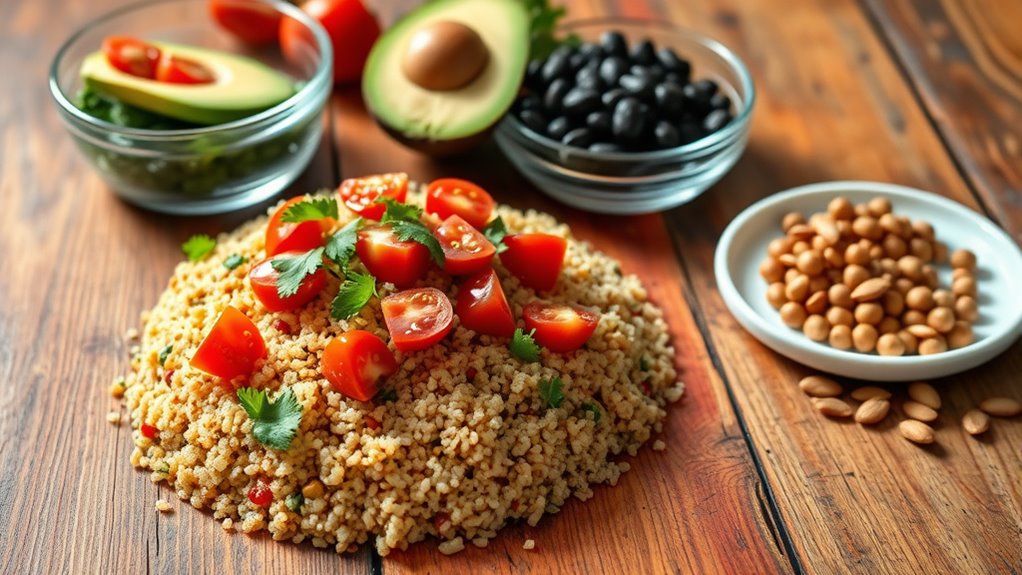
While many plant-based proteins lack certain essential amino acids, quinoa stands out as a complete protein source. Its amino acid profile includes all nine essential amino acids, making it a rare plant-based option for meeting your protein needs. This quality guarantees you get a balanced mix of nutrients critical for muscle repair, immune function, and overall health. Additionally, quinoa’s gluten-free qualities make it an ideal choice if you’re sensitive to gluten or have celiac disease. You can enjoy it confidently, knowing it won’t trigger gluten-related issues. Its versatility in the kitchen allows you to incorporate it into salads, bowls, or side dishes. By choosing quinoa, you’re adding a highly nutritious, complete protein to your vegan diet that’s both safe and beneficial. Understanding amino acids is essential for optimizing plant-based nutrition. Incorporating quinoa can also support plant-based protein diversity, broadening your nutritional options beyond common sources.
Hemp Seeds: Nutrient Powerhouses for Vegans
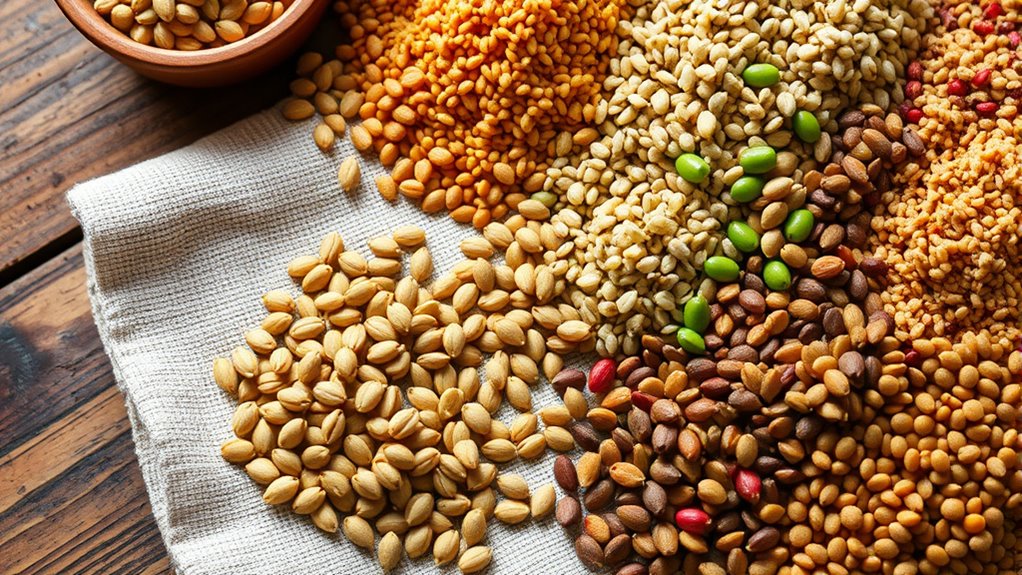
Hemp seeds are a remarkable addition to a vegan diet, offering a concentrated source of nutrients that support overall health. Rich in plant-based omega 3s, they help boost heart health and reduce inflammation. These seeds provide complete protein, containing all nine essential amino acids, making them ideal for vegans seeking variety. Incorporate hemp seeds into your meals by sprinkling them on salads, blending into smoothies, or adding to baked goods for a nutty flavor and crunchy texture. They’re also an excellent source of magnesium, zinc, and iron, essential minerals for energy and immune function. To help you visualize their benefits, here’s a quick overview: Understanding nutrient bioavailability.
| Nutrient | Benefit | Source |
|---|---|---|
| Plant-based omega 3s | Supports heart health, reduces inflammation | Hemp seeds |
| Complete protein | Builds and repairs tissues | Hemp seeds |
| Minerals | Boosts energy and immunity | Hemp seeds |
Amaranth: an Ancient Grain With Modern Benefits
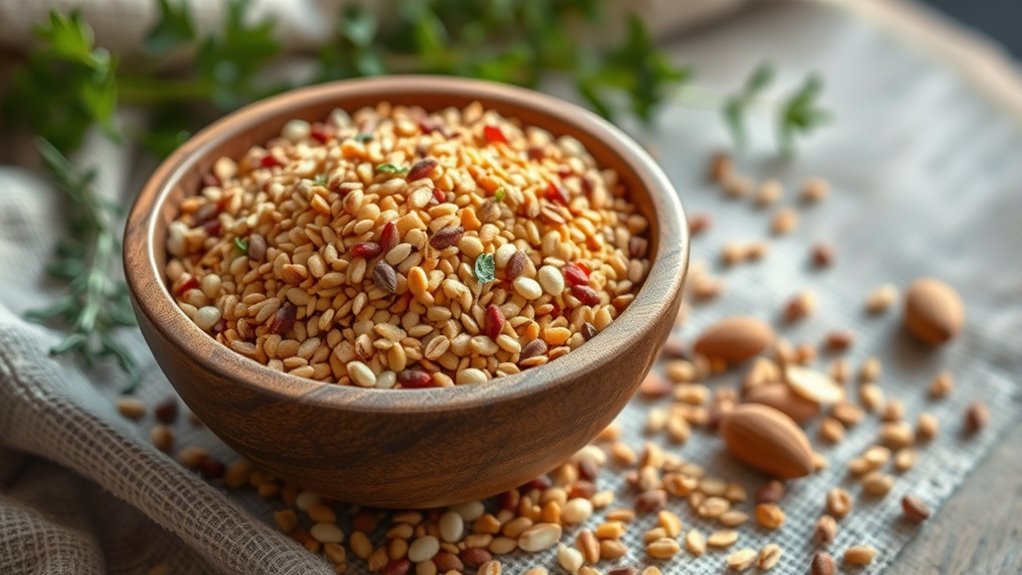
Amaranth is an ancient grain gaining popularity among vegans for its impressive nutritional profile and versatility. As one of the lesser-known ancient grains, it offers a unique source of complete protein, essential amino acids, and fiber, making it a valuable addition to plant-based diets. Its high mineral content, including calcium, magnesium, and iron, supports overall health and modern nutrition needs. Amaranth’s gluten-free nature makes it suitable for those with sensitivities, and its mild, nutty flavor complements a variety of dishes. Incorporating amaranth into your meals provides a nutritious, sustainable alternative to more common grains, helping diversify your vegan protein sources. Its historical roots and modern health benefits demonstrate how ancient grains can enhance your dietary variety and nutritional intake. Sleep and meditation practices can further optimize overall wellness when incorporating nutrient-rich foods like amaranth. Additionally, exploring lifestyle habits such as mindful eating can enhance the absorption of nutrients and support overall well-being. Understanding the nutritional profile of amaranth, including its unique relationship to traditional grains, is essential for maximizing its health benefits.
Buckwheat and Its Unique Nutritional Profile
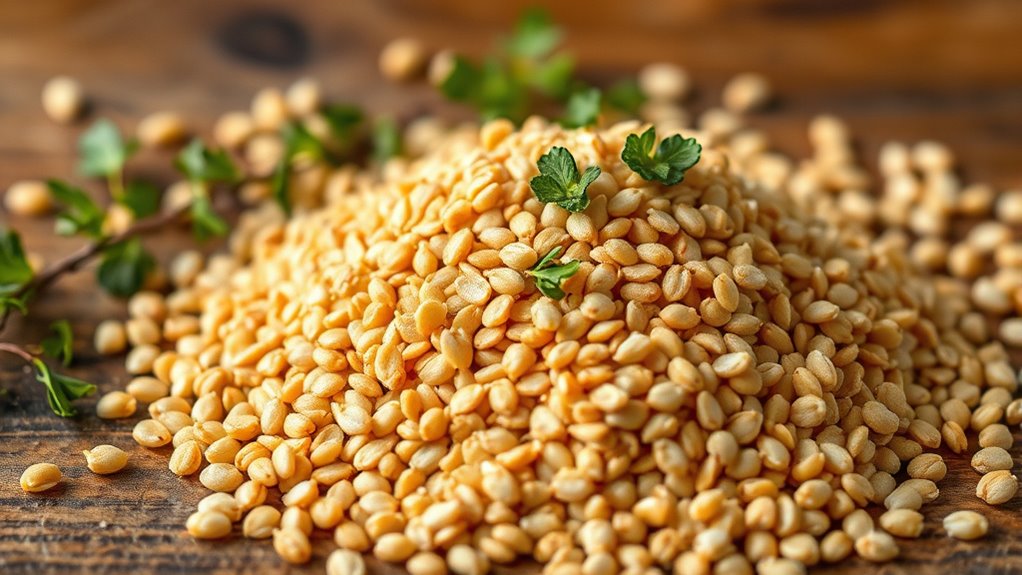
Buckwheat offers a rich nutrient profile, providing essential amino acids, fiber, and minerals that support your health. It’s naturally gluten-free, making it an excellent option for those with sensitivities or celiac disease. Plus, its versatility allows you to incorporate it into a variety of tasty, plant-based dishes. Additionally, its diverse designs and eco-friendly materials make it a sustainable choice for environmentally conscious consumers looking to expand their plant-based options. Furthermore, buckwheat’s UV filters help protect against sun damage when included in your diet, supporting overall skin health. Incorporating buckwheat into your routine can also improve your fraud detection capabilities by offering diverse nutritional benefits that align with health-conscious lifestyles. Regularly tracking your intake with meal planning tools can help maximize these benefits and ensure balanced nutrition.
Rich Nutrient Composition
Although often mistaken for a grain, buckwheat is actually a pseudo-cereal packed with essential nutrients. Its nutrient density means you get a lot of crucial vitamins and minerals in a small serving. Buckwheat is particularly rich in minerals like magnesium, manganese, and copper, which support energy production and immune health. Its mineral content surpasses many other plant-based options, making it a valuable addition to your diet. Beyond minerals, buckwheat offers high-quality plant protein and dietary fiber, contributing to overall nutrition. This unique profile ensures you’re not just adding calories but nourishing your body with key nutrients. Incorporating buckwheat into your meals boosts your nutrient diversity, helping you meet your nutritional needs while enjoying a versatile, tasty ingredient. Additionally, including a variety of plant-based proteins like buckwheat can support dog breeds like Golden Retrievers or Doxie-Poodles in a balanced diet. Moreover, the presence of nutritional benefits in buckwheat enhances its role as a comprehensive plant-based protein source, making it an excellent choice for diverse dietary needs. A widely appreciated aspect of buckwheat is its gluten-free nature, making it suitable for those with gluten sensitivities or celiac disease. By understanding the importance of mineral-rich foods, consumers can better appreciate how buckwheat contributes to overall health. Incorporating sound design techniques such as layering and manipulation can help improve the sensory experience of food presentation, engaging the senses more effectively.
Gluten-Free and Versatile
Because it’s naturally gluten-free, buckwheat offers a safe and versatile option for those with gluten sensitivities or celiac disease. Its unique nutritional profile makes it perfect for creating gluten free snacks and versatile meal ideas. You can enjoy buckwheat as a hearty porridge, use it as a base for salads, or make gluten-free pancakes. Its adaptability extends to baked goods, offering a nutty flavor without gluten. Here are four reasons to incorporate buckwheat into your diet:
- High-quality protein source
- Rich in antioxidants and fiber
- Easy to prepare and cook
- Suitable for various recipes and cuisines
In addition, the absence of common allergens in buckwheat makes it a safe gluten-free alternative for many consumers. Incorporating buckwheat can also support sustainable agriculture, as it is often grown with minimal pesticides and has a low environmental impact. Its nutritional benefits include being a complete protein, which makes it a valuable addition to vegetarian and vegan diets.
Sunflower Seeds and Their Versatile Uses
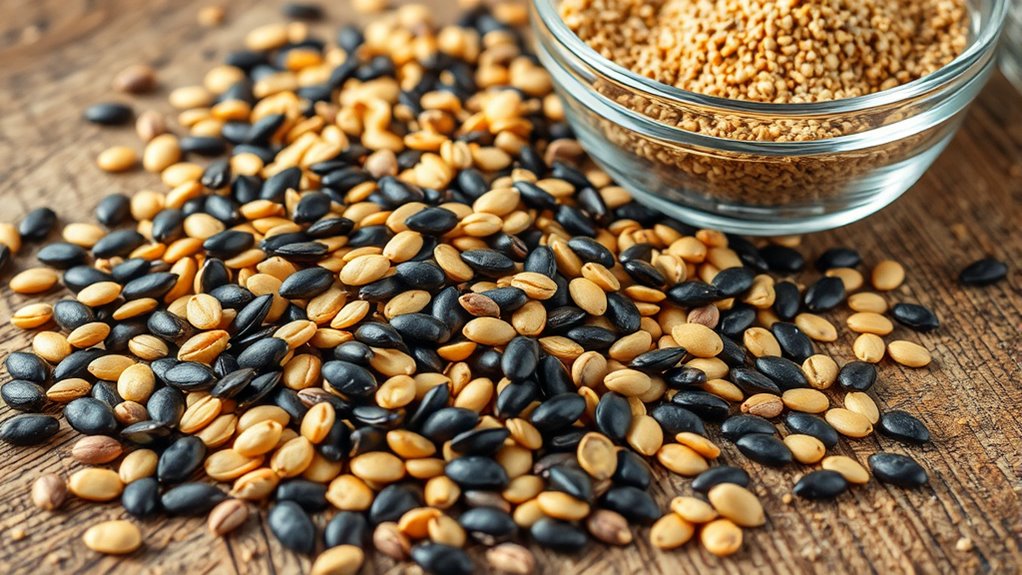
Have you ever considered how versatile sunflower seeds really are? These tiny seeds pack a punch in snack versatility. You can enjoy them roasted and salted as a quick snack or sprinkle them over salads and oatmeal for added crunch. Sunflower seeds are also perfect for making homemade trail mix or blending into smoothies. Beyond snacking, seed oil benefits make sunflower oil a popular choice for cooking due to its light flavor and health advantages, like heart-healthy fats. You can even incorporate ground sunflower seeds into baked goods or energy bars for extra nutrition. Their mild flavor and nutrient density make sunflower seeds a flexible ingredient in your vegan diet, offering both taste and health benefits without hassle. Additionally, sunflower seeds are a good source of omega-3 fatty acids, which support overall heart health and reduce inflammation.
Chia and Flaxseeds: Tiny Seeds, Big Nutrition

Building on the versatility of sunflower seeds, chia and flaxseeds stand out as tiny powerhouses packed with nutrients. These seeds are rich in omega-3 fatty acids, offering notable seed oil benefits that support heart health. They also boast impressive fiber content analysis, helping digestion and promoting satiety. Here are four key points about these seeds:
- Chia seeds swell when soaked, creating a gel-like texture perfect for puddings.
- Flaxseeds are best ground to release their full nutritional potential.
- Both seeds are excellent sources of plant-based protein.
- Their high fiber content aids in digestion and stabilizes blood sugar levels.
Incorporating chia and flaxseeds into your diet boosts nutritional diversity while providing essential fats, fiber, and protein—making them valuable additions for any vegan diet.
Lentils and Legumes: Staple Proteins in Plant-Based Diets
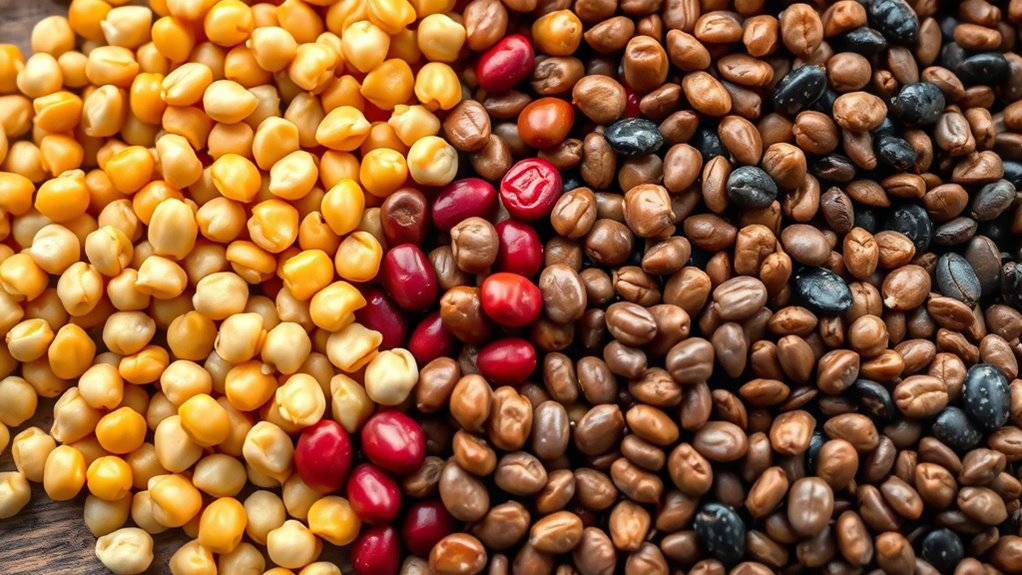
Lentils and legumes are essential for adding plant-based protein to your diet, offering impressive nutritional benefits. You can prepare them in various ways, from soups to salads, making them versatile in the kitchen. Exploring different varieties expands your culinary options and helps you maximize their health advantages.
Nutritional Benefits of Lentils
Because they are rich in protein, lentils stand out as a vital component of plant-based diets, providing essential nutrients your body needs. Their high-quality protein supports ideal protein absorption, guaranteeing your muscles and tissues get what they require. Additionally, lentils are packed with dietary fiber, which aids digestion and promotes gut health. Here are some key benefits:
- Rich in plant-based protein to support muscle maintenance
- High dietary fiber content for improved digestion
- Provides essential minerals like iron and magnesium
- Low in fat, making them heart-friendly and weight-conscious
These nutrients work together to boost your energy, support immune function, and promote overall wellness. Incorporating lentils into your meals guarantees that you get a nutrient-dense, versatile, and sustainable source of plant protein.
Cooking and Preparation Tips
Cooking lentils and other legumes is a straightforward way to access their nutritional benefits and incorporate more plant-based protein into your meals. To guarantee they’re tender and flavorful, rinse them thoroughly before cooking, then simmer in water or broth until soft. For added flavor and nutrition, consider using plant based sauces or spices during cooking for flavor enhancement. Soaking lentils beforehand can reduce cooking time and improve digestibility. Once cooked, you can mash or leave them whole, depending on your dish. Pair lentils with herbs, spices, or a splash of vinegar to elevate their taste. Proper preparation makes legumes versatile and delicious, helping you create hearty, protein-rich plant-based meals effortlessly.
Varieties and Culinary Uses
Among the most versatile and widely used plant-based proteins, lentils and legumes come in a variety of types, each offering unique flavors and textures suitable for different culinary applications. Their culinary versatility allows you to create hearty soups, salads, stews, and spreads. To enhance flavor pairings, consider pairing lentils with spices like cumin or herbs like thyme. Here are some popular varieties:
- Brown Lentils – mild flavor, ideal for soups and stews
- Red Lentils – quick-cooking, perfect for curries and purees
- Chickpeas – nutty taste, great for hummus and salads
- Black Beans – earthy flavor, excellent in Latin-inspired dishes
Mycoprotein: Fungi-Based Meat Alternatives
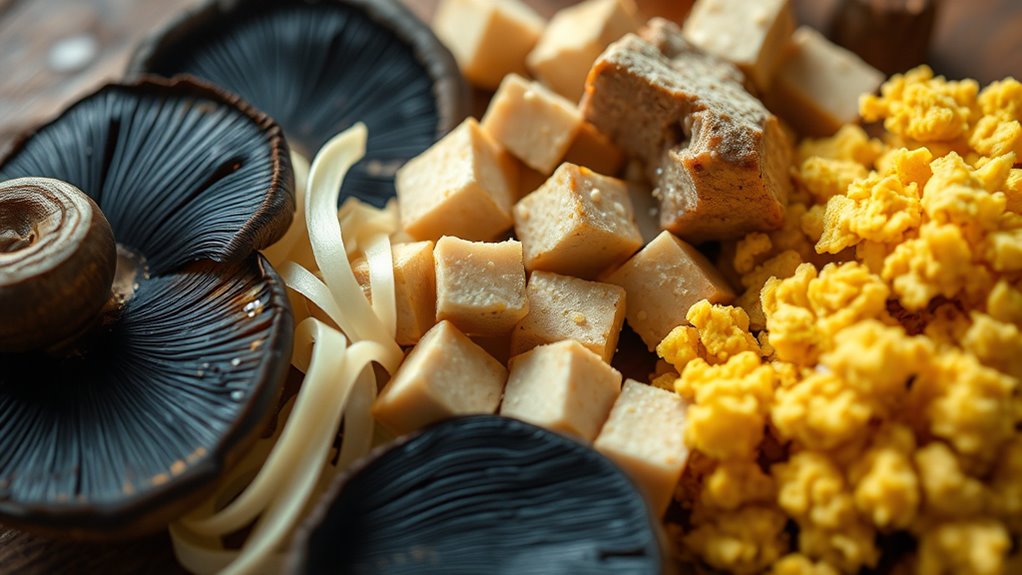
Mycoprotein, a fungi-based meat alternative, has gained popularity for its sustainability and high nutritional value. It’s created through fungi cultivation, where fungi are grown efficiently on minimal resources. This process produces a protein-rich biomass that mimics meat’s texture, making it appealing to those seeking plant-based options. The meat texture of mycoprotein is firm yet tender, closely resembling chicken or beef, which helps satisfy cravings for traditional meat dishes. Its versatility allows it to be shaped into nuggets, patties, or grounds for various recipes. Plus, fungi cultivation requires less land and water compared to animal farming, making it an eco-friendly choice. If you’re looking for a sustainable, protein-dense alternative that mimics real meat, mycoprotein offers a compelling option.
Seitan: Wheat Gluten as a Protein Source

Seitan, also known as wheat gluten, serves as a popular plant-based protein source for vegetarians and vegans alike. Its high protein content comes from the protein extraction process, where wheat gluten is isolated from wheat flour. This versatile ingredient can mimic meat textures when cooked properly. To get the best seitan, keep in mind:
- It’s made by washing away starch during wheat gluten extraction.
- You can flavor it with soy sauce, spices, or broth.
- Its protein density rivals some animal products.
- It’s suitable for various dishes, from stews to sandwiches.
Wheat gluten provides a hearty, chewy texture that makes it a favorite for many plant-based diets. Its protein extraction process ensures you get a concentrated source of plant protein, boosting your nutrition and culinary options.
Edamame and Other Young Legumes
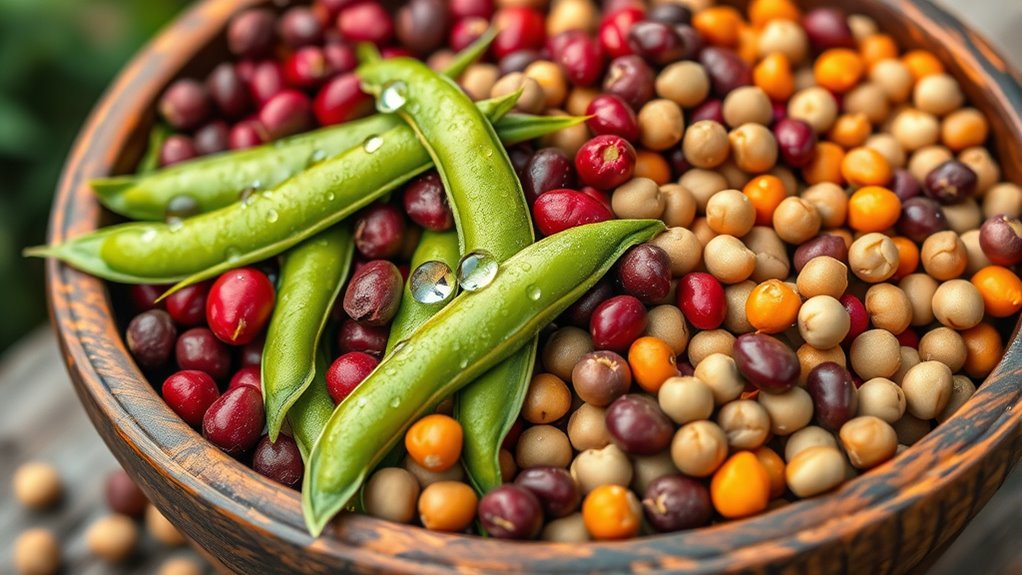
Have you explored edamame and other young legumes as sources of plant-based protein? Edamame offers notable health benefits, including high protein content, fiber, and antioxidants that support digestion and heart health. These young soybeans are harvested using specialized techniques that preserve their tenderness and nutrient levels, typically when pods are still green and immature. Edamame harvesting techniques involve careful timing and gentle handling to prevent damage and ensure ideal flavor and texture. Besides edamame, other young legumes like fava beans and mung beans also provide valuable protein options for vegans. Incorporating these into your diet diversifies your plant-based protein sources while offering a range of nutrients essential for overall health. Their versatility makes them an excellent addition to salads, stir-fries, and snacks.
Frequently Asked Questions
Are There Any Allergenic Risks Associated With Newer Plant-Based Proteins?
You might wonder if newer plant-based proteins pose allergenic risks. While they can offer alternatives, there’s still a chance of allergen cross-reactivity, especially if you’re sensitive to related plants. Hidden allergen risks exist in processed products where ingredients aren’t fully disclosed. Always check labels carefully, and consider consulting an allergist if you’re concerned about potential reactions to these emerging protein sources.
How Do Amino Acid Profiles Vary Among Alternative Vegan Proteins?
Imagine comparing amino acid profiles like charting different landscapes—each with its peaks and valleys. When you examine alternative vegan proteins, their amino acid completeness varies, creating diverse nutritional terrains. Through profile comparison, you see how some sources, like quinoa or amaranth, offer complete proteins, while others may lack certain amino acids. This variation helps you choose proteins that best meet your dietary needs, ensuring balanced nutrition from plant-based sources.
Can These Diverse Proteins Meet All Essential Nutrient Requirements?
You might wonder if these diverse vegan proteins can fulfill all your essential nutrient needs. While some, like quinoa and amaranth, offer nutritional completeness, others may lack certain amino acids. Incorporating a variety of these proteins guarantees you get a balanced intake, covering all essential nutrients. Dietary variety not only improves nutrient profiles but also supports overall health, making it easier to meet your nutritional requirements without relying solely on soy and pea proteins.
What Environmental Impacts Are Linked to Cultivating These Lesser-Known Proteins?
Did you know that cultivating lesser-known plant proteins can reduce water use by up to 90% compared to traditional crops? You might wonder about their environmental impacts. These proteins often support sustainable farming practices, conserving resources and reducing greenhouse gases. Plus, they promote biodiversity conservation by diversifying crop systems, which can help protect ecosystems. By choosing these protein sources, you contribute to a more eco-friendly food system and a healthier planet.
How Accessible and Affordable Are These Alternative Vegan Protein Sources Globally?
You might wonder about the accessibility and affordability of alternative vegan proteins worldwide. Their economic feasibility varies, often depending on production scale and local infrastructure. In some regions, cultural acceptance influences how quickly these proteins become mainstream. While costs are decreasing as technology advances, global disparities remain. You can expect more widespread availability over time, but you’ll still encounter challenges related to affordability and cultural preferences that shape adoption.
Conclusion
Exploring these diverse plant-based proteins unleash a treasure chest of nutrition beyond soy and peas. Each offers unique flavors and benefits, turning your diet into a vibrant tapestry of options. Think of it as a garden bursting with colorful blooms—there’s always something new to discover. Embrace this variety, and you’ll nourish your body with a symphony of nutrients, proving that vegan protein diversity is truly an infinite horizon waiting to be explored.
Hi, I’m Alexander. I’m a vegan of over 20 years, and I initially made the switch for health reasons. However, as time went on, I became more and more passionate about the ethical and environmental implications of leading a vegan lifestyle.
I am the author of The Graceful Kitchen, a vegan blog where I share recipes for delicious and nutritious vegan meals. As someone who is deeply committed to living a cruelty-free life, I am also a strong advocate for using whole foods as the foundation of a healthy diet – and believe that going vegan is one of the best ways to achieve this.









